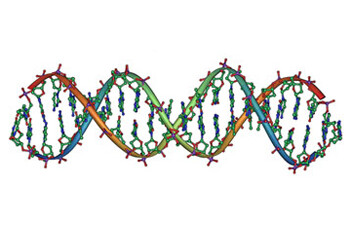Victor Lustig became one of the most notorious con men in history by selling the Eiffel Tower for scrap—twice. Posing as a representative of the French government, he convinced his marks that he had the authority to cut a deal.
As a general rule, it pays to be skeptical of someone looking to sell something they can't possibly own. The human genetic code would appear to fit into this category. Yet, a new bill before the U.S. Congress seeks to end the practice of patenting human genes. You read that right. Since the mid-1990s, the United States Patent and Trademark Office (USPTO) has been granting patents for the genetic material that we all share. And they've been doing it at an alarming rate.
According to a 2005 study by Kyle Jensen and Fiona Murray of the Massachusetts Institute of Technology, patents cover nearly 20 percent of the human genes recognized by the U.S. government—a figure they called "surprisingly high". The University of California, Incyte Pharmaceuticals, Human Genome Sciences Inc., and Genentech are among the top patent holders.
According to U.S. law, a patent grants the holder "the right to exclude others from making, using, offering for sale, or selling" the patented invention. How does one exclude others from making use of genetic material? The same way one goes about recycling one of the man-made wonders of the world—by trading on the legitimacy that governments can offer.
The United States Patent and Trademark Office (USPTO) uses four criteria to assess the patent-worthiness of an invention. Generally, patents are awarded to inventions that are useful, new, non-obvious, and presented to the USPTO in a sufficiently detailed manner. These standards mean it's impossible to patent genes as they exist in the human body. But by isolating a gene in a unique way or developing a particular therapeutic use for it, patent requests can be tailored to fit USPTO requirements.
"Genes are a product of nature; they were not created by man, but instead are the very blueprint that creates man, and thus, are not patentable. Gene patenting [is] the analogous equivalent to patenting water, air, birds or diamonds," said California Rep. Xavier Becerra, the sponsor of the Genomic Research and Accessibility Act.
The molecule that contains the genetic information, instructions and functions of nearly all living organisms is deoxyribonucleic acid or DNA. James Watson and Francis Crick first decoded its exact structure in 1953. The Human Genome Project, started in 1990, brought together more than 2,000 scientists from 20 institutions in six countries to identify all of the genes present in the human genome. It is questionable whether this information can be considered the exclusive property of a single individual or entity.
"Ordinarily, we imagine patents promote innovation, but that's because most patents are granted for human inventions. Genes aren't human inventions, they are features of the natural world," writes physician-turned-author Michael Crichton in an op-ed this month in The New York Times. "You can't patent snow, eagles or gravity, and you shouldn't be able to patent genes, either."
Crichton provides an extreme, yet real example of the dangers associated with patenting genetic material. In 1993, a group of families coping with Canavan's disease—an inherited brain disorder leading to paralysis and death in children—organized an effort to jumpstart the search for a cure. The Canavan families gathered DNA samples from around the world and raised funding for research into its exact genetic cause. The research led directly to the identification of the gene causing Canavan's disease, but the hospital where the discovery was made moved quickly to patent the gene and demanded royalty payments in exchange for the right to test it.
"Genes are a product of nature; they were not created by man, but instead are the very blueprint that creates man, and thus, are not patentable. Gene patenting would be the analogous equivalent to patenting water, air, birds or diamonds," said Becerra while introducing his bill in Congress.
"The practice of gene patenting is preventing critical research from advancing because scientists are wary of trespassing patent laws. This not only violates the spirit of the Human Genome Project, it hinders the discovery of medical breakthroughs that could save lives. Our bill is a common sense measure to ensure that genes yet unpatented remain the province of science," said Rep. David Weldon, M.D., co-sponsor of the new bill.
Critics worry that removing patent protections will cause private firms to turn away from potentially beneficial research. In rare cases, such as that of the Canavan families, research projects are funded by investors uninterested in financial returns. But it is unreasonable to expect that biotechnology firms will fund speculative research without the expectation of a return on their investment. To date, over $350 billion has been plunged into research and development by the world's 4,000 biotechnology firms.
Its sponsors point out that the new law will not be retroactive. Current patent holders will remain the sole proprietors of their intellectual property for the 20 years that U.S. patent law now allows. Becerra and Weldon hope this lag will give policymakers and biotech firms time to develop a more equitable set of standards for the development of genetic therapies.
At a 2001 conference, Tim Hubbard, one of the researchers involved in the Human Genome Project, spoke of the current system's inherent flaw. "If you have a patent on a mousetrap, rivals can still make a better mousetrap. This isn't true in the case of genomics. If someone patents a gene, they have a real monopoly."





